

Compact Muon Solenoid
LHC, CERN
| CMS-EXO-17-010 ; CERN-EP-2021-029 | ||
| Search for strongly interacting massive particles generating trackless jets in proton-proton collisions at $\sqrt{s} = $ 13 TeV | ||
| CMS Collaboration | ||
| 19 May 2021 | ||
| Eur. Phys. J. C 82 (2022) 213 | ||
| Abstract: A search for dark matter in the form of strongly interacting massive particles (SIMPs) using the CMS detector at the LHC is presented. The SIMPs would be produced in pairs that manifest themselves as pairs of jets without tracks. The energy fraction of jets carried by charged particles is used as a key discriminator to suppress efficiently the large multijet background, and the remaining background is estimated directly from data. The search is performed using proton-proton collision data corresponding to an integrated luminosity of 16.1 fb$^{-1}$, collected with the CMS detector in 2016. No significant excess of events is observed above the expected background. For the simplified dark matter model under consideration, SIMPs with masses up to 100 GeV are excluded and further sensitivity is explored towards higher masses. | ||
| Links: e-print arXiv:2105.09178 [hep-ex] (PDF) ; CDS record ; inSPIRE record ; HepData record ; CADI line (restricted) ; | ||
| Figures | |
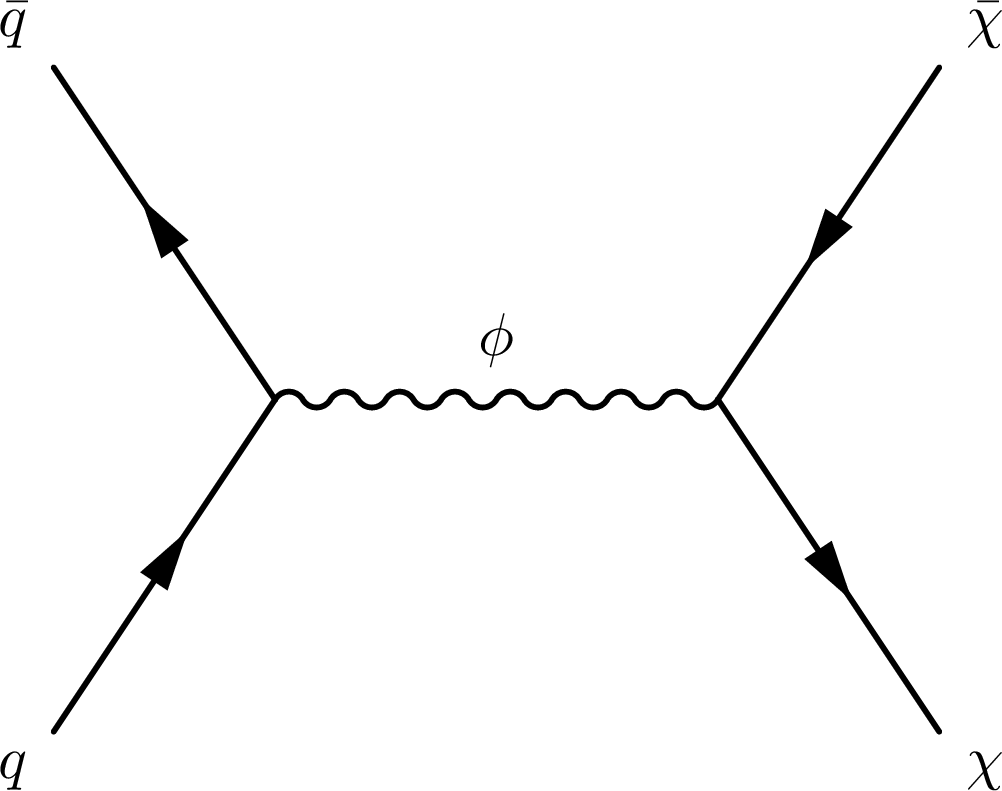
png pdf |
Figure 1:
A Feynman diagram showing SIMP pair production via the s-channel exchange of a new scalar mediator. |
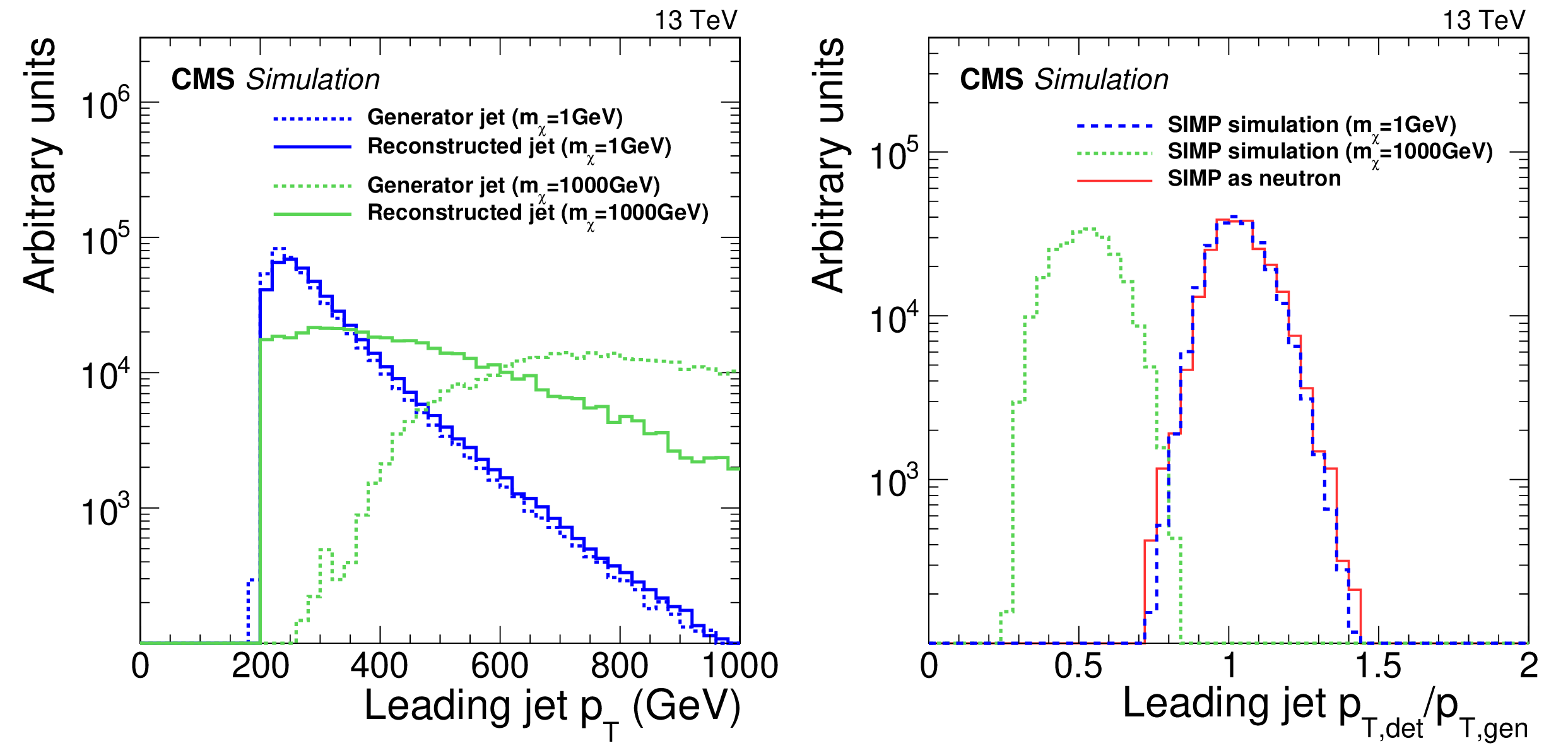
png pdf |
Figure 2:
Left: comparison of the leading jet $ {p_{\mathrm {T}}} $ spectrum between jets clustered at the generator level (dashed lines) and after detector simulation (solid lines), arising from the GEANT4 SIMP simulation at masses of 1 GeV (blue lines) and 1000 GeV (green lines); right : the ratio of the reconstruction-level and generator-level jet transverse momenta for the GEANT4 SIMP simulation at masses of 1 GeV (dark blue, long-dashed line) and 1000 GeV (green, short-dashed line), including a comparison to a simulation where a 1 GeV SIMP is replaced by a neutron (red, solid line). |

png pdf |
Figure 2-a:
Comparison of the leading jet $ {p_{\mathrm {T}}} $ spectrum between jets clustered at the generator level (dashed lines) and after detector simulation (solid lines), arising from the GEANT4 SIMP simulation at masses of 1 GeV (blue lines) and 1000 GeV (green lines). |
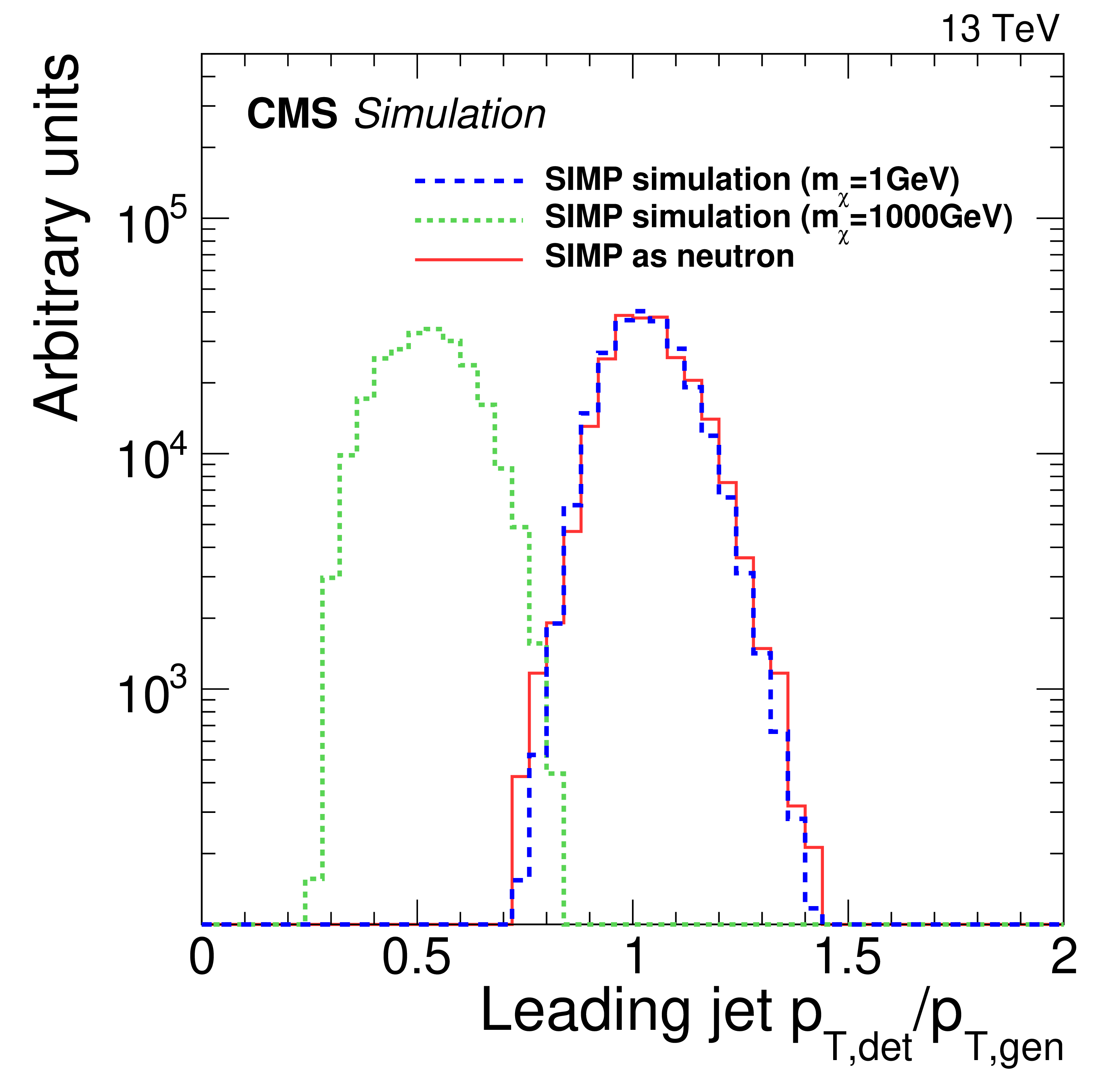
png pdf |
Figure 2-b:
The ratio of the reconstruction-level and generator-level jet transverse momenta for the GEANT4 SIMP simulation at masses of 1 GeV (dark blue, long-dashed line) and 1000 GeV (green, short-dashed line), including a comparison to a simulation where a 1 GeV SIMP is replaced by a neutron (red, solid line). |
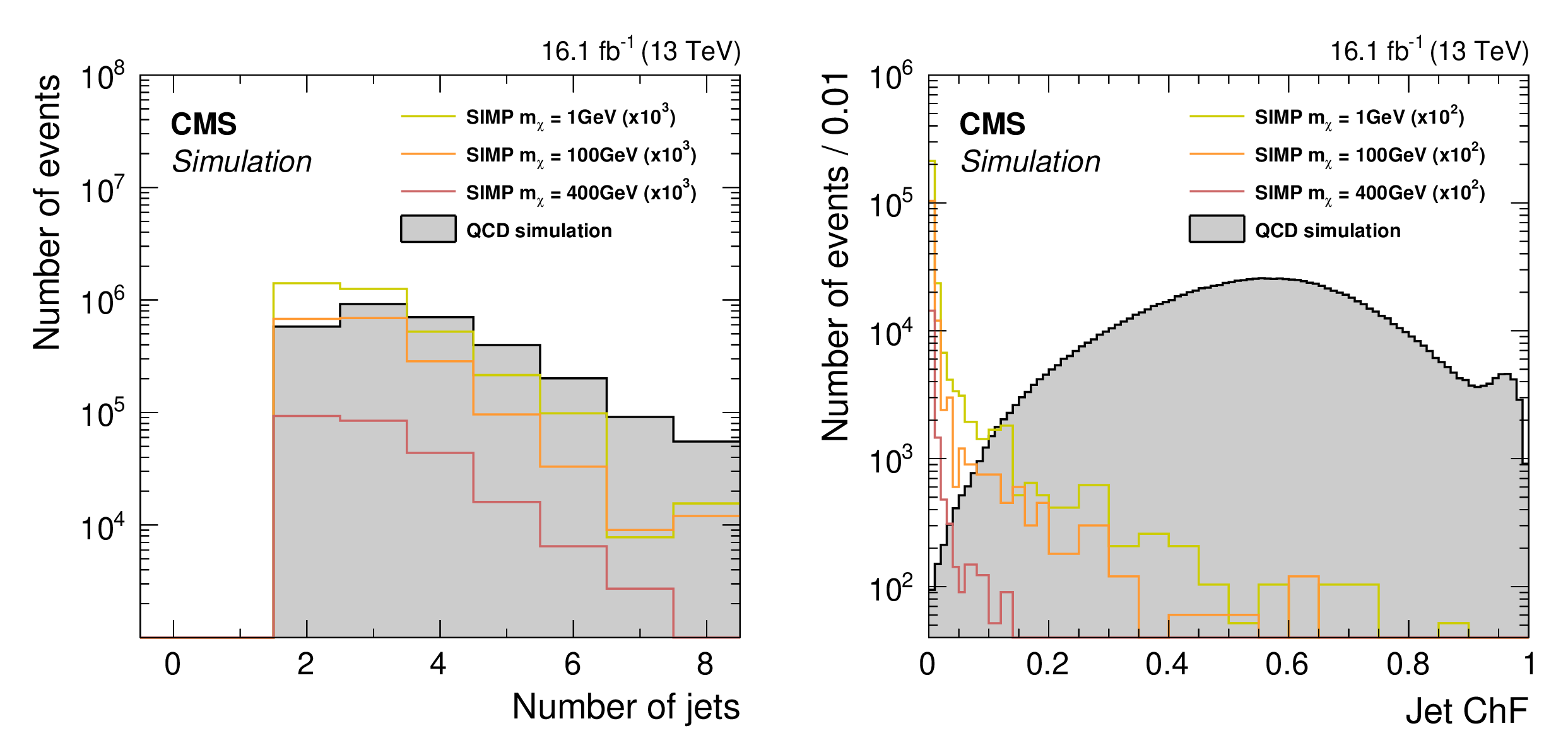
png pdf |
Figure 3:
Distributions of the number of jets with $ {p_{\mathrm {T}}} > $ 30 GeV and $ {| \eta |} < $ 5 (left), and the value of ChF of the two leading jets (right). The simulated QCD multijet background is compared with the signal expected for three different SIMP masses, with their cross sections scaled as indicated in the legend. The baseline selection is applied, except the events with three or more jets with $ {p_{\mathrm {T}}} > $ 30 GeV and $ {| \eta |} < $ 5 are included in the number of jets in the left plot. |

png pdf |
Figure 3-a:
Distribution of the number of jets with $ {p_{\mathrm {T}}} > $ 30 GeV and $ {| \eta |} < $ 5. The simulated QCD multijet background is compared with the signal expected for three different SIMP masses, with their cross sections scaled as indicated in the legend. The baseline selection is applied. The events with three or more jets with $ {p_{\mathrm {T}}} > $ 30 GeV and $ {| \eta |} < $ 5 are included in the plot. |

png pdf |
Figure 3-b:
The value of ChF of the two leading jets. The simulated QCD multijet background is compared with the signal expected for three different SIMP masses, with their cross sections scaled as indicated in the legend. The baseline selection is applied. |
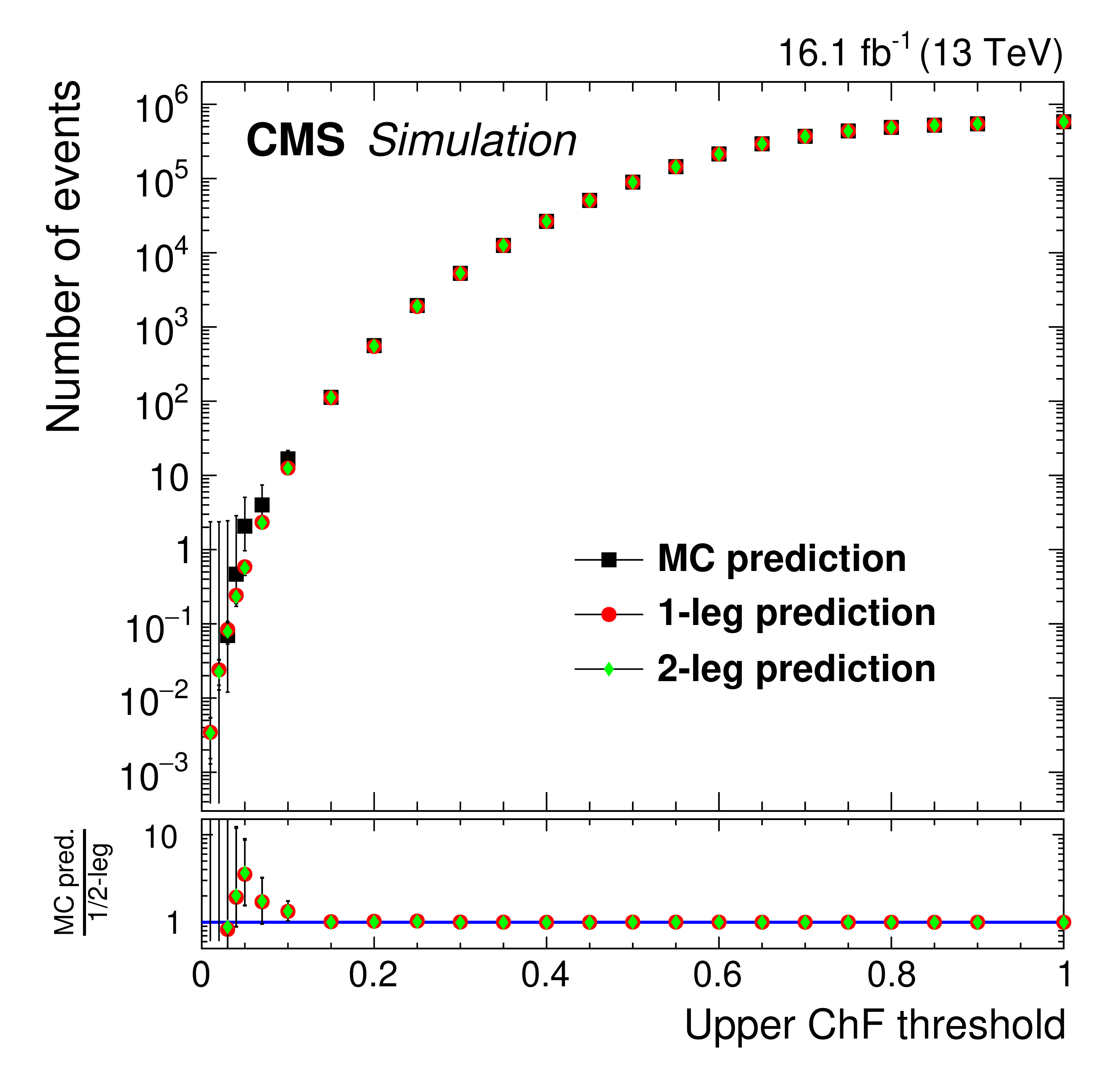
png pdf |
Figure 4:
The number of background events obtained from the 1- and 2-leg predictions using reconstructed objects in simulation, compared to the direct prediction from MC simulation, shown for various upper ChF thresholds. The bottom panel shows the ratios of the MC prediction to the 1-leg and the 2-leg background predictions. |
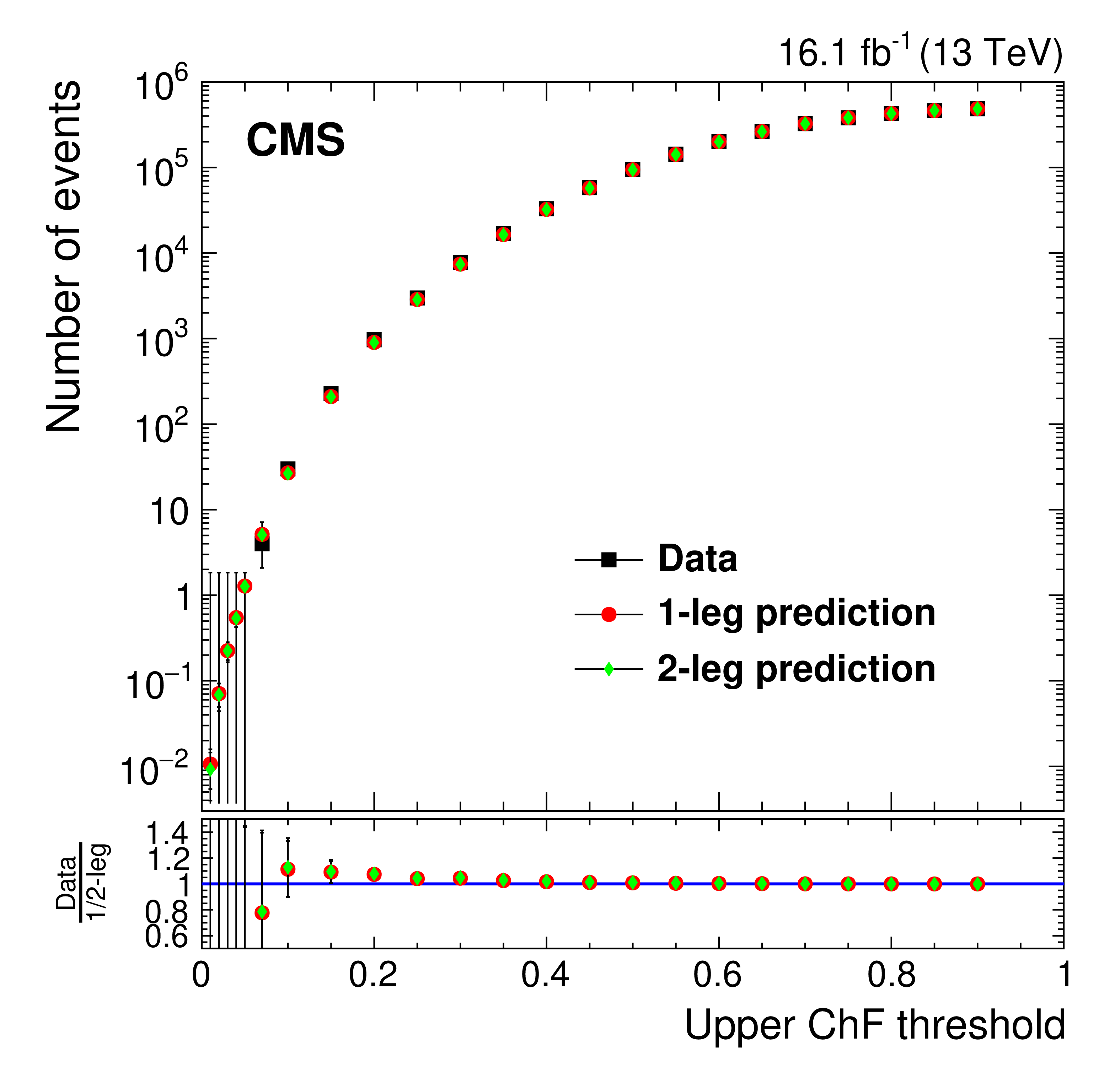
png pdf |
Figure 5:
The number of background events obtained from the 1- and 2-leg predictions derived from data, together with the direct observation in data, in bins in ChF, where either the leading or subleading jet has a ChF within the bin edges, and both have a ChF below the upper bin threshold. The bottom panel shows the ratios of the observation in data to the 1-leg and the 2-leg background predictions. |

png pdf |
Figure 6:
The expected and observed 95% CL upper limits on the production cross section for SIMPs with masses between 1 and 1000 GeV, with the assumption that the SIMP interaction in the detector can be approximated as neutron-like. The theoretical prediction of a simplified model incorporating this approximation and including a scalar mediator with couplings $g_\chi = $ $-$1 and $g_\mathrm{q} = $ 1 is also shown (red line). For masses above 100 GeV, where the modelling of the SIMP-nucleon interaction becomes more speculative, the obtained cross section upper limits are increasingly uncertain (shaded area). |
| Tables | |

png pdf |
Table 1:
The numbers of background and observed events for different upper bounds on the ChF value. The background estimations are derived using the data-based 2-leg predictions. The expected number of signal events is given for the $m_{\chi} = $ 1, 100, and 1000 GeV scenarios, with the corresponding statistical uncertainties. |
| Summary |
| A search has been presented for dark matter in the form of strongly interacting massive particles (SIMPs) manifesting themselves in the detector as trackless jets. The large multijet background is efficiently suppressed using the charged energy fraction of jets as the key discriminator. The remaining background is estimated directly from data. Using proton-proton collision data corresponding to an integrated luminosity of 16.1 fb$^{-1}$ collected by the CMS experiment in 2016, we set first limits on the production cross section for SIMPs with masses between 1 and 1000 GeV at 95% confidence level (CL), using a signal simulation that assumes the SIMP interaction in the detector can be approximated as neutron-like. The signal modelling assumptions stated previously have small uncertainties, and hence a small impact on the cross section upper limits, for SIMP masses up to about 100 GeV, but become increasingly uncertain above 100 GeV, where an improved phenomenology of the SIMP-nucleon interaction would be welcome. Within this framework we exclude SIMPs with masses less than 100 GeV. These limits were obtained for the off-shell production of SIMP pairs, through a new scalar mediator with couplings $g_\chi = $ $-$1 and $g_{\mathrm{q}} = $ 1. An upper limit on the fiducial cross section of 0.18 fb at 95% CL is also provided for a generic signal of high-momentum trackless jets. With this search, strongly interacting massive particles, for which the interaction strength is constrained to generate a trackless jets signature, have been ruled out over a wide mass range. |
| References | ||||
| 1 | E. W. Kolb and M. S. Turner | The Early Universe | CRC Press. Taylor & Francis Group, 1990 Front. Phys., vol. 69 | |
| 2 | G. Bertone and D. Hooper | History of dark matter | Rev. Mod. Phys. 90 (2018) 045002 | 1605.04909 |
| 3 | N. Daci et al. | Simplified SIMPs and the LHC | JHEP 11 (2015) 108 | 1503.05505 |
| 4 | Y. Bai and A. Rajaraman | Dark matter jets at the LHC | 1109.6009 | |
| 5 | CMS Collaboration | HEPData record for this analysis | link | |
| 6 | ATLAS Collaboration | Search for long-lived neutral particles in $ pp $ collisions at $ \sqrt{s} = $ 13 TeV that decay into displaced hadronic jets in the ATLAS calorimeter | EPJC 79 (2019) 481 | 1902.03094 |
| 7 | J. H. Davis | Probing sub-GeV mass strongly interacting dark matter with a low-threshold surface experiment | PRL 119 (2017) 211302 | 1708.01484 |
| 8 | CRESST Collaboration | Results on MeV-scale dark matter from a gram-scale cryogenic calorimeter operated above ground | EPJC 77 (2017) 637 | 1707.06749 |
| 9 | EDELWEISS Collaboration | Searching for low-mass dark matter particles with a massive Ge bolometer operated above-ground | PRD 99 (2019) 082003 | 1901.03588 |
| 10 | D. Hooper and S. D. McDermott | Robust constraints and novel gamma-ray signatures of dark matter that interacts strongly with nucleons | PRD 97 (2018) 115006 | 1802.03025 |
| 11 | T. Emken and C. Kouvaris | How blind are underground and surface detectors to strongly interacting dark matter? | PRD 97 (2018) 115047 | 1802.04764 |
| 12 | CMS Collaboration | Performance of the CMS Level-1 trigger in proton-proton collisions at $ \sqrt{s} = $ 13 TeV | JINST 15 (2020) P10017 | CMS-TRG-17-001 2006.10165 |
| 13 | CMS Collaboration | The CMS trigger system | JINST 12 (2017) P01020 | CMS-TRG-12-001 1609.02366 |
| 14 | CMS Collaboration | The CMS experiment at the CERN LHC | JINST 3 (2008) S08004 | CMS-00-001 |
| 15 | A. Alloul et al. | FeynRules 2.0---A complete toolbox for tree-level phenomenology | CPC 185 (2014) 2250 | 1310.1921 |
| 16 | J. Alwall et al. | The automated computation of tree-level and next-to-leading order differential cross sections, and their matching to parton shower simulations | JHEP 07 (2014) 079 | 1405.0301 |
| 17 | T. Sjostrand et al. | An introduction to PYTHIA 8.2 | CPC 191 (2015) 159 | 1410.3012 |
| 18 | CMS Collaboration | Event generator tunes obtained from underlying event and multiparton scattering measurements | EPJC 76 (2016) 155 | CMS-GEN-14-001 1512.00815 |
| 19 | GEANT4 Collaboration | GEANT4--a simulation toolkit | NIMA 506 (2003) 250 | |
| 20 | CMS Collaboration | Particle-flow reconstruction and global event description with the CMS detector | JINST 12 (2017) P10003 | CMS-PRF-14-001 1706.04965 |
| 21 | M. Cacciari, G. P. Salam, and G. Soyez | The anti-$ {k_{\mathrm{T}}} $ jet clustering algorithm | JHEP 04 (2008) 063 | 0802.1189 |
| 22 | M. Cacciari, G. P. Salam, and G. Soyez | FastJet user manual | EPJC 72 (2012) 1896 | 1111.6097 |
| 23 | CMS Collaboration | Jet energy scale and resolution in the CMS experiment in pp collisions at 8 TeV | JINST 12 (2017) P02014 | CMS-JME-13-004 1607.03663 |
| 24 | CMS Collaboration | Performance of photon reconstruction and identification with the CMS detector in proton-proton collisions at $ \sqrt{s} = $ 8 TeV | JINST 10 (2015) P08010 | CMS-EGM-14-001 1502.02702 |
| 25 | CMS Collaboration | Performance of missing transverse momentum reconstruction in proton-proton collisions at $ \sqrt{s} = $ 13 TeV using the CMS detector | JINST 14 (2019) P07004 | CMS-JME-17-001 1903.06078 |
| 26 | T. Junk | Confidence level computation for combining searches with small statistics | NIMA 434 (1999) 435 | hep-ex/9902006 |
| 27 | A. L. Read | Presentation of search results: the CLs technique | JPG 28 (2002) 2693 | |
| 28 | CMS Collaboration | CMS luminosity measurements for the 2016 data taking period | CMS-PAS-LUM-17-001 | CMS-PAS-LUM-17-001 |

|
Compact Muon Solenoid LHC, CERN |

|

|

|

|

|

|